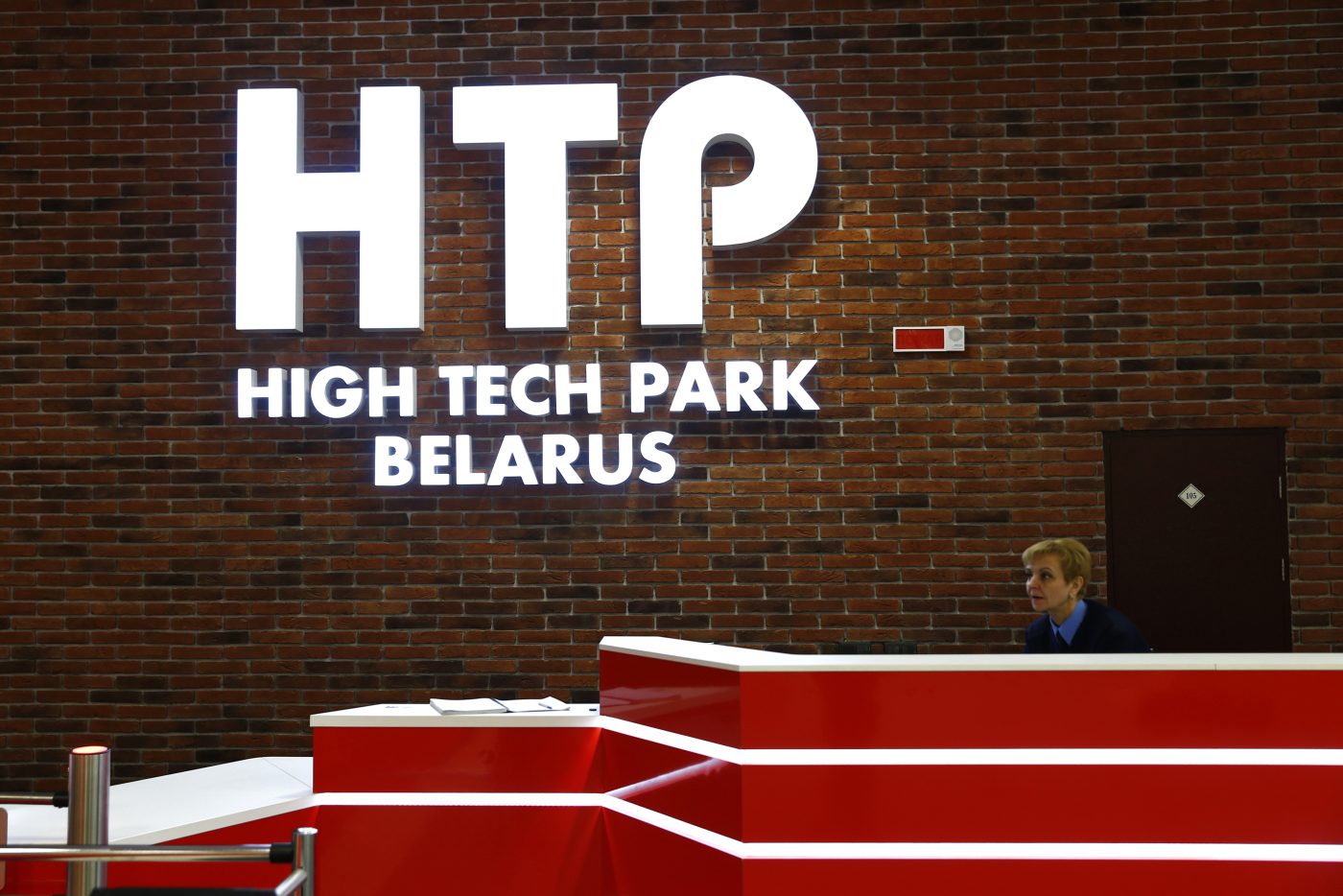Under communism, Soviet planners chose Belarus to be a key center for the electronics industry. During the 1950s and 1960s, Belarus began producing TV sets, radios, computing equipment, optics, and microcircuits for the military and space industries. The Minsk Radio-Technical Institute opened in 1964; today, the institute counts 16,000 students.
After the Soviet Union’s collapse, Belarus’s digital leaders took advantage of open borders. In 1993, two Belarusian programmers founded EPAM Systems, which became Central Europe’s largest developer of custom software and the region’s first IT company listed on the New York Stock Exchange.
During the early 2000s, the Lukashenka government launched a Hi-Tech Park, offering special rules to encourage digital businesses. Unlike most Western and Asian technology parks, which are a cluster of buildings in a particular area, Belarus’ Hi-Tech Park is virtual. Its legal regime applies throughout the country. Park residents are exempted from profit tax and VAT, benefit from reduced income tax, and pay reduced contributions to the Social Insurance Fund.
The scheme succeeded. During the first five years of operation, from 2006 to 2010, the Hi-Tech Park’s exports increased close to tenfold, from $22 million to $215 million. In addition to writing software for Westerners, Belarusian companies developed their own products, even if this was more of an exception than the rule. In 2010, developer Wargaming published the multiplayer game ‘World of Tanks.’ At its peak, Wargaming was valued at $3 billion, making its founder Viktor Kyslyy one of Belarus’ richest citizens.
Encouraged by these success stories, the government liberalized even further. In 2017, it published a new decree introducing certain institutions of English law for Hi-Tech Park residents. Belarus became the first country in the world to legalize blockchain smart contracts. The list of business areas covered under the Hi-Tech Park expanded to include artificial intelligence, biotechnology, and the development of unmanned vehicles.
During the first six months after the new decree, the number of Belarusian companies in the park more than doubled. The following year, IT exports grew by 40%. Software became Belarus’s main economic engine. In 2019, it accounted for half of all GDP growth — as much as manufacturing, construction, agriculture, forestry, fisheries, and trade combined. Total exports of HTP residents’ services for 2019 exceeded $2 billion. In 2020, US Secretary of State, Mike Pompeo, visited Belarus and wrote that he was “Inspired by what I saw at the Hi-Tech Park.”
The growing prominence of Belarus’ IT sector raised hopes that it could help open the country’s state-dominated economy and, perhaps, reform its stagnant, repressive politics. Techies played an important role in the 2020 presidential election. One of authoritarian President Aliaksandr Lukashenka’s main rivals in the election race was Hi-Tech Park founder Valery Tsepkalo.
Developers built crowdfunding platforms and sophisticated digital solutions for documenting election rigging, including the online platform Golos (Voice). Before casting their ballots, voters were asked to take a photo and upload it to a special mobile app, indicating their constituency. The software processed all the ballots, spotting inconsistencies with the official data. A total of 1.6 million Belarusians registered on the platform (more than 20% of eligible voters), with more than a million of them uploading their votes. The analysis identified numerous falsifications, estimating that official counts understated votes for opposition leader Sviatlana Tsikhanouskaya by a factor of 13.
After incumbent President Lukashenka claimed a landslide victory, IT leaders rushed to the front lines of mass protests. Mikita Mikado, the founder of the Belarusian unicorn start-up PandaDoc, set up a fund to offer free IT education to police officers who resigned from the force. Employees of his company’s Minsk office were arrested. Other IT developers created digital solutions to coordinate protests and strikes. Developer Andrei Maksimov created software that revealed the identity of Belarusian security officers. He claimed his algorithm was able to recognize the face of a person involved in the crackdown, even if it was hidden behind a mask or balaclava.
A group called Cyber Partisans emerged. Their founder, who remains anonymous, broke into the website of the Belarusian Chamber of Commerce and Industry and posted a riddle. Those who solved the riddle were given a contact address for the founder. The Cyber Partisans defaced state websites, interrupted online streams of state TV channels, put Alexander Lukashenka and his ministers on the police most wanted list, and engaged in other ‘minor mischiefs.’
In July 2021, databases belonging to the Belarus Ministry of Internal Affairs suddenly stopped working. For almost two weeks, the Ministry could not carry out many administrative procedures, such as issuing new passports or registering cars. The Cyber Partisans hacked the traffic police database, giving them access to details of all vehicle owners in Belarus, including details of traffic violations and photographs of licenses. The partisans even hacked into the 102-emergency line database and identified everyone who had ever called the police, recording the reasons for their calls. From this data, they created a Black Map of regime supporters who had reported their neighbors or co-workers to the police for agitating for the opposition candidates or for taking part in protests.
The group claimed to have gained access to an archive of police CCTV footage as well as 5.3 million wiretapped phone records, including those of top police and security officials. Commenting on the hack, Gabriella Coleman, a professor at McGill University and an expert on hacktivism, said: “I don’t think there are a lot of parallels to this, that they are so sophisticated and are attacking multiple levels, it’s not something I’ve seen before except in the movies.” The hack helped reveal that Covid killed more than 32,000 Belarussians — 14 times more than the authorities claimed.
Lukashenka’s authoritarian regime counterattacked. The president promised revenge on the rebellious IT workers: “I’ve already created a paradise for them. But no, it turns out they want more,” he declared, denouncing the privilege of the “petty bourgeois, rich people and IT workers.” He called Arkady Dobkin, founder of EPAM, a “scoundrel” and accused him of working for Western intelligence services.
IT specialists started to flee. During the first year of the political crackdown, up to 20,000 IT workers left the country, an estimated 5 to 10% of the total sector employees. “There is no person in Belarus today who has not been affected by repression,” said Vera Reshetina, co-founder of the start-up ‘Workee.’ Before moving abroad, Reshetina participated in the start-up accelerator ‘Imaguru,’ which was forced to close. Her husband’s daughter and a developer of her start-up were both detained.
Neighboring countries, particularly Poland, Lithuania, and Latvia, took advantage. In September 2020, Poland launched the Poland Business Harbour (PBH) scheme to facilitate the relocation of Belarusian professionals. As of October 2022, more than 53,000 Belarusian IT workers and their family members had received Polish visas. The Lithuanian government made it easy for Belarusian emigrants to open bank accounts, set up companies, and declare taxes online. The Latvian authorities set up a special group to expedite the processing of visa applications.
Russia’s invasion of Ukraine would send new waves of Belarus IT workers fleeing.
Andrew Wilson is Professor of East European Studies at University College London. Yale University Press recently released the fifth updated version of his book The Ukrainians: The Story of How a People Became a Nation.”
Tadeusz Giczan is a Non-resident Fellow with CEPA. He is a London-based journalist with Infopoint Media Network and a PhD candidate at University College London, School of Slavonic and East European Studies.
Bandwidth is CEPA’s online journal dedicated to advancing transatlantic cooperation on tech policy. All opinions are those of the author and do not necessarily represent the position or views of the institutions they represent or the Center for European Policy Analysis.






